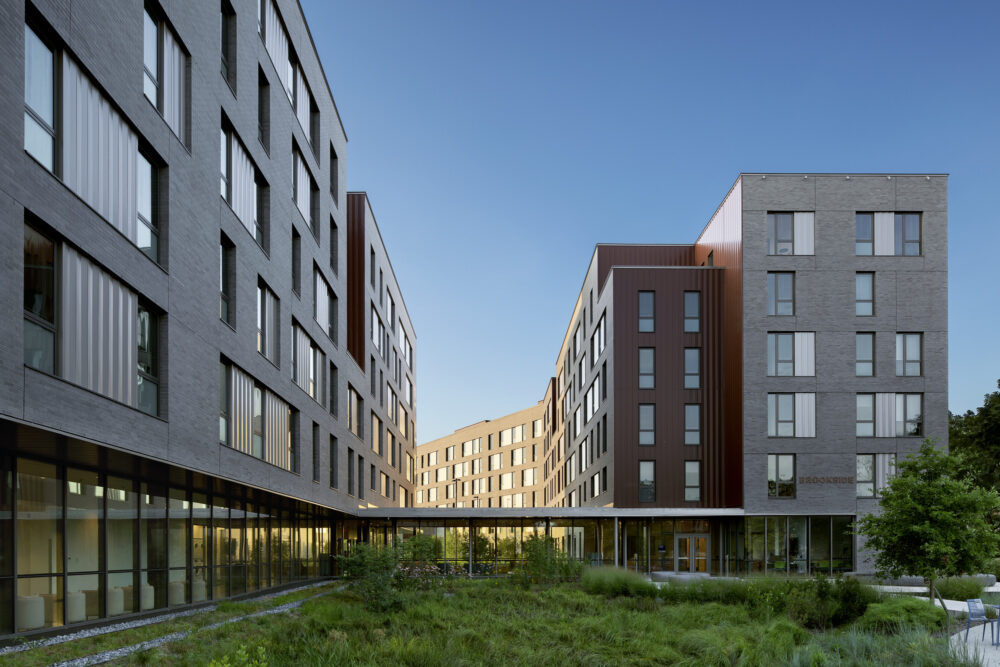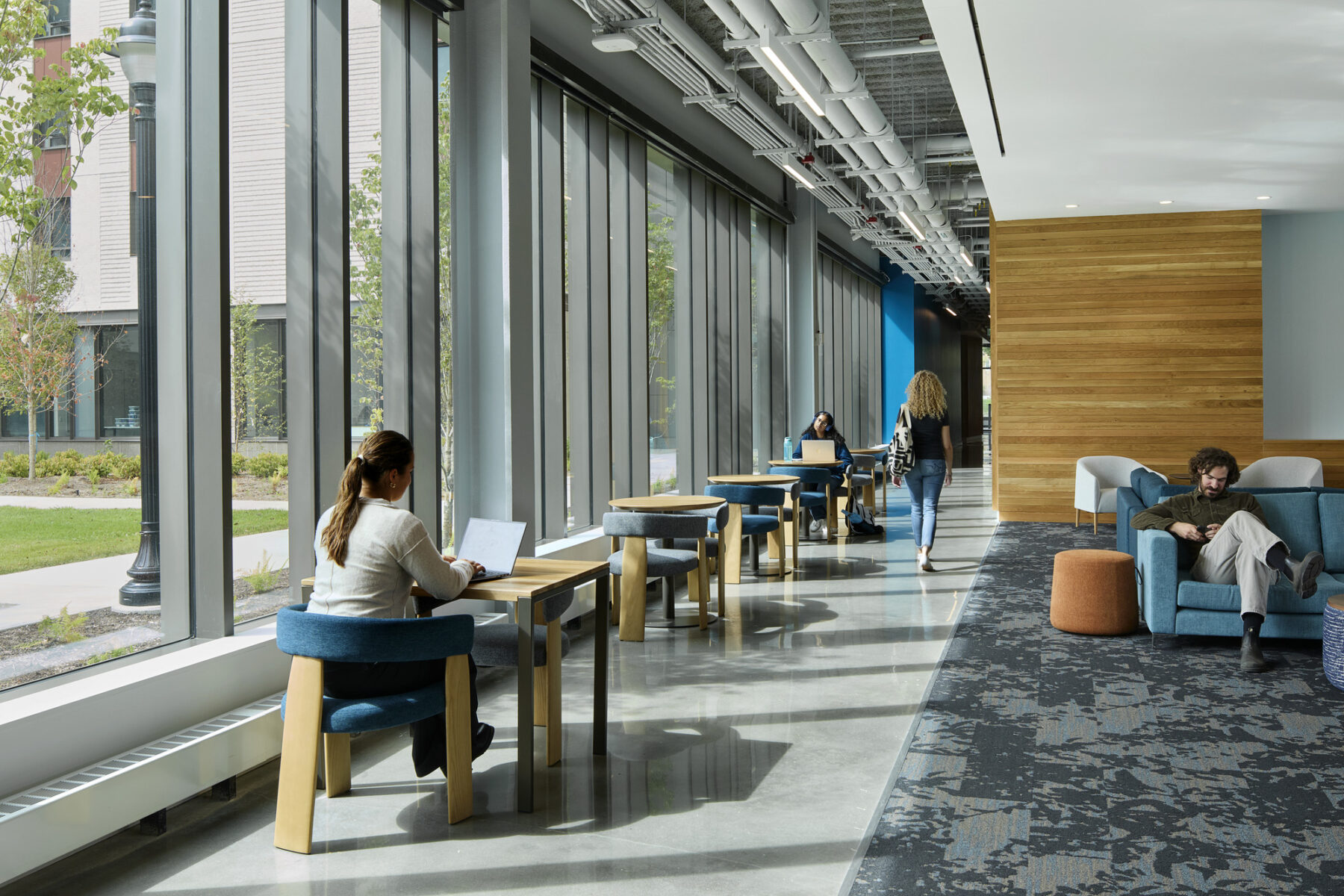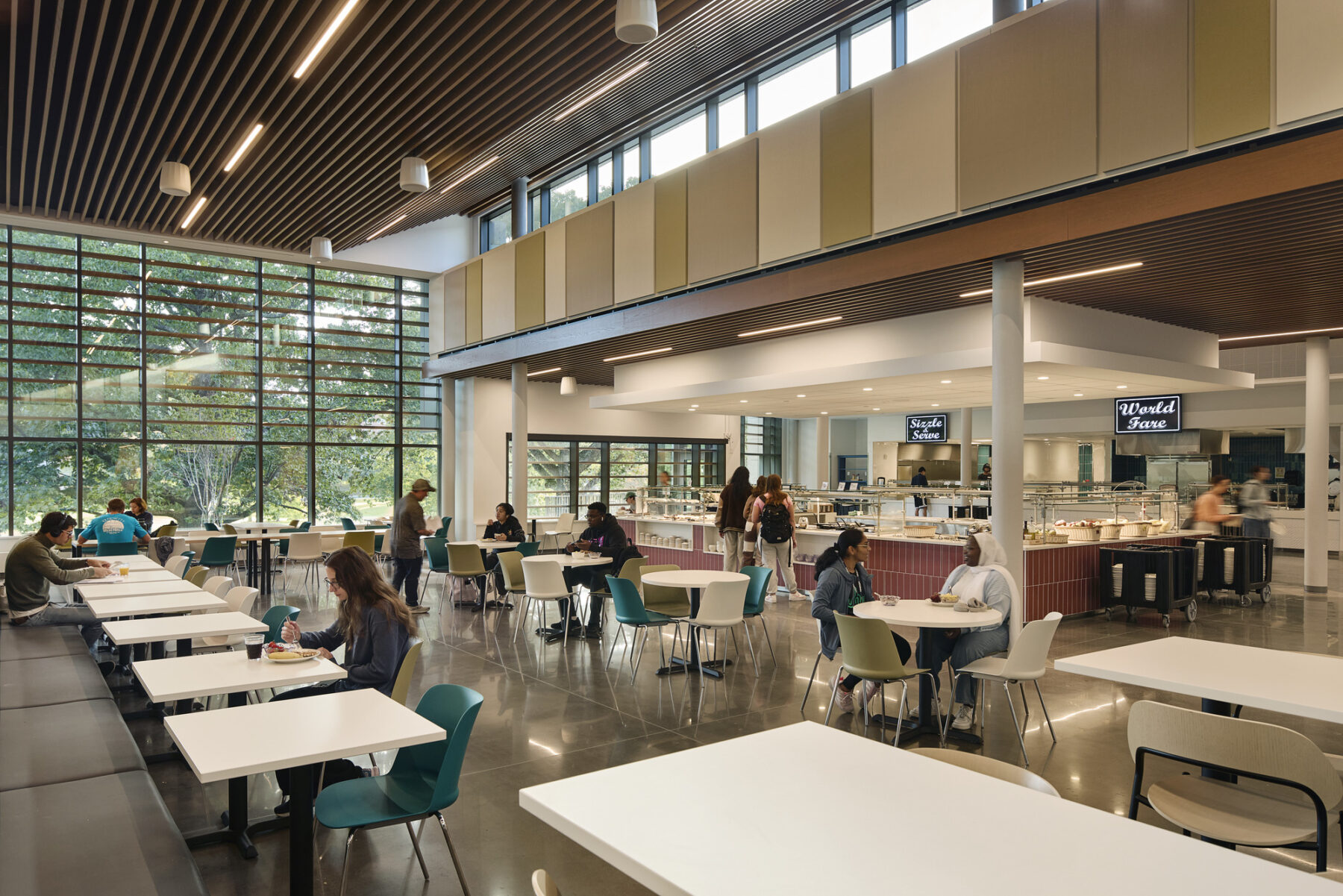
罗德岛大学布鲁克塞德公寓及景观恢复
美国罗德岛州金士顿市
 Sasaki
Sasaki

康涅狄格大学南校区新宿舍楼与学生餐厅是 Sasaki 在该校2019 年校园住房规划中的第一个更新项目。以精心的项目开发著称,该项目通过多样的住宿房型、学习和社交空间以及与住宅专业人员交流的机会,为学生全面发展提供支持。
南校区宿舍楼在校园中心为学生打造了全新的生活和就餐体验。这座七层楼高的建筑提供了拥有657个床位的多样房型,可容纳500人的餐厅,以及充足的休闲空间。凭借巧妙的选址和与既有宿舍楼的组合,新宿舍楼创造了崭新的室外休闲空间和学生生活中心。

校园规划平面图

该宿舍楼为现已完工的住宿区提供了两个新门户,填补了既有宿舍楼附近功能不明的荒废空地。其中一个门户位于曼斯菲尔德路的校园主要入口,另一个则紧邻校园的主要人行道–学术大道。新建筑背靠古树群,毗邻镜湖,其设计旨在建立两个重要的室外空间:与现有宿舍共享、可供日常和非正式休闲活动使用的新绿地,以及更为社交性的四合院广场,可供所有学生聚会使用。

新宿舍楼界定出两个户外空间让学生交流休憩
宿舍楼有两个主要入口。第一个入口与餐厅和社交广场相连,也是该生活区学生穿越校园的 “捷径”,引导学生前往能欣赏到镜湖和周围的迷人景色的餐厅。第二个入口则引领住宿学生通往建筑的核心,一个让教职员工和学生聚集的公共空间。
该项目设计旨在满足不同学生的生活方式,包括享受大型社交群体生活的学生,以及更希望拥有独立使用体验的学生。不同类型的寝室分布在各个楼层;半套房式寝室有两种配置:一种是拥有两个双人间的四人寝室,共用卫生间;另一种是同样共用卫生间、一人一房的双人寝室。其他房间类型包括单人半套房和全套房,也都有各自的公用空间和浴室。设计团队亦将无障碍设施纳入全面考虑,以保障建筑的包容性与学生的归属感。
除了学生和教职员工宿舍外,宿舍楼还为住户和康大社区提供了其他空间可能性,如研讨会厅和多功能公共活动室、宿舍楼客厅、自行车室、游戏间、每层楼的中性卫生间、多层休息室和灵活自习室。在建筑首层,共享的公共空间可直接通往庭院,再次与校园连结,并创造出日照充足、通透的社交空间,为所有人带来开放感和无障碍的社交空间。

半套房式的寝室

通透的大厅可以将庭院一览无遗,提供充足的自然光与开放的空间体验

位于建筑首层的休闲活动区

配置灵活的自习室
半套房式的寝室
通透的大厅可以将庭院一览无遗,提供充足的自然光与开放的空间体验
位于建筑首层的休闲活动区
配置灵活的自习室
餐厅的体量和通透玻璃幕墙使其成为现有主入口干道上的新地标,以及加强校园交通动线与景观视野的标志。 餐厅的规模和布局与标准餐桌、高脚桌和定制长椅等家具的分布相辅相成,家具的选择注重灵活性,可支持多元的社交活动,并提供由共享餐饮带来的群体交流机会。
除了主要用餐区,还有五个小型餐站,为学生提供满足各种饮食限制和偏好的餐饮选择。餐厅的位置设计考量了车辆通行的便利性,方便车辆进入服务区,使例如送餐与废弃物清理等厨房设施的运作更加顺畅。

餐厅的大面玻璃幕墙让镜湖美景尽收眼底,水平木制遮板则有助缓和直射强光

南校区学生宿舍楼和学生餐厅的景观通过调节周围景象并聚焦于两个庭院来建立其独特性。第一个庭院与相邻的宿舍楼共用,小型露台和花岗岩长凳沿人行道布置,提供休闲空间。该区域与建筑融为一体,不仅为就近楼内社交空间提供绿色环境,也为教职员办公室提供绿植缓冲区。
第二个庭院是具备高社交性的四合院广场,设有可通过宿舍楼客厅和餐厅进入的露台。除了花岗岩长凳外,还布置有为各种社交聚会提供的灵活桌椅。新的景观利用校园标准照明、标识和材料,沿吉尔伯特路形成了轮廓分明的街景,同时为校园班车和显眼的行人入口提供了一个新的连接点。在大楼西侧,景观延续了学术大道的材料和视觉样式,无缝连接了已建成的校园步行道。

建筑与校园主要干道学术大道相融
设计团队采用本地乡土植物支持生物多样性,最大程度地减少灌溉需求,并遵守既定的景观设计准则。此外,在设计文件编制过程中确定了全面的树木保护导则,以确保施工期间成龄大乔木的健康。雨水花园和人行广场沿街修建,巧妙地解决地形变化和雨水管理问题。这些景观设施在改善现有校园开放空间的同时,也能帮助管理场地中大部分雨水的水质和水量。
该建筑与新的校园地热场相连,并旨在获得 LEED 金级认证。该项目于 2024 年夏季完工,第一批学生已在新学年开始时入住。
想了解更多项目细节,请联系 Fiske Crowell或Vinicius Gorgati.